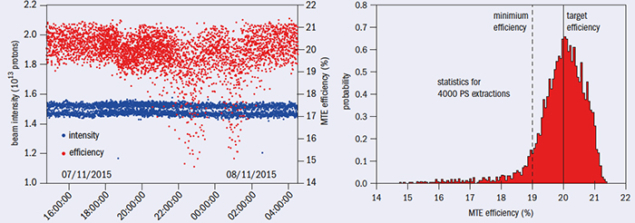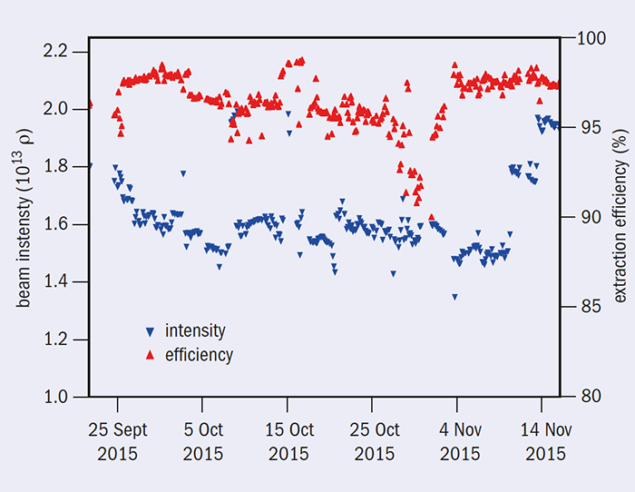Successful tests for more efficient proton-beam extraction.
Résumé
L’extraction des faisceaux du PS devient plus efficace
Depuis septembre 2015, les faisceaux de protons utilisés pour les expériences de physique avec cible fixe auprès du Supersynchrotron à protons du CERN sont produits par un nouveau système d’extraction à partir du Synchrotron à protons. Ce système, plus efficace, est appelé système d’extraction multitours (MTE). Les tests ayant été probants dans l’ensemble, le MTE sera, en 2016, le mode d’extraction standard pour l’exploitation avec cible fixe auprès du SPS. D’ici le milieu de l’année prochaine, une décision définitive sera prise sur le futur à long terme du MTE.

Image credit: CERN.
First thought of in 2002 with the goal of significantly reducing beam losses that cause high ring activation, the Multi-Turn Extraction (MTE) system (CERN Courier March 2009 p29) has, since then, encountered numerous challenges during its implementation in the Proton Synchrotron (PS). Now, the regular MTE operation over the last two months constitutes a crucial milestone for this new beam manipulation, and paves the way for further studies and optimisations.
The lows
In 2010, MTE was the default choice to deliver beam for the Super Proton Synchrotron (SPS) physics run. However, after only a few weeks of operation for the production of neutrinos in the framework of the CNGS programme, the PS extraction mode had to revert back to Continuous-Transfer (CT) extraction, which is associated with high beam losses along the ring circumference. This feature was the reason for studying an alternative extraction mode. In the new scheme, the beam is split horizontally into five beamlets – one in the centre and four in stable islands of the horizontal phase space. Unfortunately, the intensity sharing between the islands and the centre (figure 1) and the extraction trajectories were fluctuating on a cycle-to-cycle basis. This was not only significantly affecting the beam transmission through acceleration in the SPS, but also prevented proper optimisation of the SPS parameters. In addition, activation of the PS extraction region had increased anomalously, although the rest of the ring was profiting from a significant reduction in radiation levels with respect to CT operation.
Intense investigations were undertaken to find the source of the observed variations and to overcome the PS ring activation. The latter problem proved to be much easier to solve than the former.

Image credit: CERN.
The increased activation was tackled by designing a new piece of hardware, a so-called dummy septum, which is a passive septum with only a copper blade and no coils for generating a guiding magnetic field. The dummy septum is supposed to intercept protons from the de-bunched beam during the extraction-kickers’ rise time, therefore preventing them from interacting with the blade of the active extraction septum. This approach, combined with appropriate shielding of the dummy septum, provides a well-localised loss point that is acceptable in terms of overall activation of the PS ring. It is worth noting that the use of a shadowing device for the main extraction septum is a known approach in, for example, the SPS. However, in a small ring like the PS, the two devices cannot easily be located next to each other, which makes the overall configuration more complicated in terms of beam dynamics.
A side effect of the implementation of the dummy-septum solution is that the horizontal aperture of the PS ring is reduced, which calls for a complete review of all PS fast-extraction schemes to make them compatible with the presence of the dummy septum. This additional hurdle was overcome and the proposed solution looked acceptable on paper.
During Long Shutdown 1 (February 2013–May 2014) the design, construction, and installation of the dummy septum was completed, together with some modifications to the powering of the extraction bump. The beam commissioning of the whole system, including the new extractions, was completed successfully by the end of 2014.
To tackle the fluctuations of the extraction trajectories, systematic observations of hardware parameters in the PS ring, such as the currents of the key magnetic elements controlling the machine configuration, were undertaken. The aim was to find a correlation with the changes in intensity sharing between beamlets. Despite the long and detailed observations, no evidence for the guilty element was found, and the sources of fluctuations remained unidentified.
The highs
Activities to track down the origin of the fluctuations in the intensity sharing and of the extraction trajectories of the MTE beam resumed at the beginning of the 2015 physics run. Eventually, it was possible to identify a correlation between these variations and the amplitude of a 5 kHz ripple present on the current of some special circuits located in the PS main magnets (figure 1). The PS ring is made up of 100 combined-function main magnets with additional coils installed on the magnets’ poles. These so-called pole-face windings (PFWs) and figure-of-eight loops allow control of the working point in terms of tunes and linear chromaticities, and some higher-order parameters such as the second-order chromaticity. The ensemble of the electrical circuits present in the main magnets and the interaction between the various components is extremely complex; all switching-mode power converters feature a ripple at 5 kHz with a varying phase, which turned out to be the culprit of the observed fluctuations.

Image credit: CERN.
This crucial observation guided the power-converter experts to implement mitigation measures (additional inductances to filter the ripple amplitude), and their expected effect was immediately observed as improvement of the stability of the MTE beam parameters (figure 2).
This milestone again opened up the route to transfer to the SPS, and first tests of beam delivery were conducted in the summer of 2015. Their success accelerated the subsequent steps, which culminated in the decision to use MTE for fixed-target physics: after the low of 2010, MTE was back in business.
Of course, this was just the start rather than the end of efforts. The studies, which were conducted on both the PS and SPS rings, continued in view of improving the overall beam quality. The intensity was raised from an initial value of about 1.6 × 1013 protons extracted from the PS to about 2.0 × 1013 protons at the end of the run, with extraction efficiency in the PS around 98% (figure 3).
By the end of the run, the PS Booster joined the challenge, managing to produce brighter beams in the vertical plane to improve SPS transmission, which is plagued by limitation of the vertical aperture. The final touch was the finalisation of the dummy-septum configuration.
Promising future
The progress and future of MTE were discussed in two internal reviews in 2015. Given the overall success of the MTE studies, commissioning and operation during the last part of the physics run, MTE will be the standard extraction mode for the 2016 fixed-target run at the SPS. This is a necessary step to acquire better knowledge of the new beam manipulation, and also understand the limitations coming from the existing hardware. In parallel, studies to probe the beam behaviour for even higher intensities will be carried out. This is important in view of future projects requiring even more intense beams than those delivered today. By the middle of next year, a firm decision concerning the long-term future of MTE and its predecessor CT will be taken.
• For all MTE-related documents (design report, publications and talks), visit ab-project-mte.web.cern.ch/AB-Project-MTE/Documents.html.





